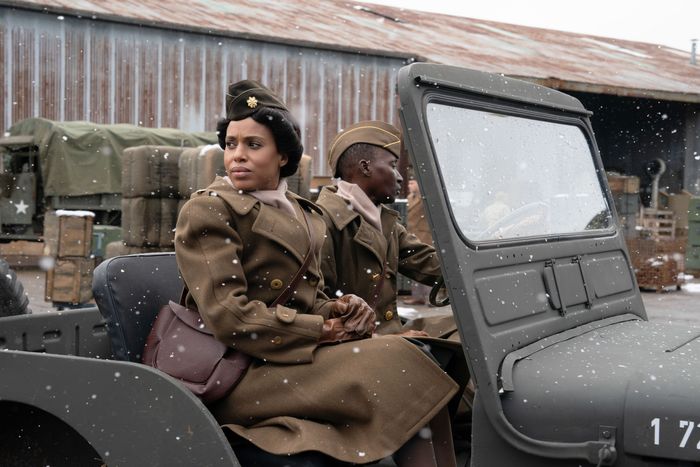
This review was originally published on December 6, 2024. We are recirculating it now that The Six Triple Eight is streaming on Netflix.
It’s difficult to make administrative work exciting onscreen, no matter how important it might have been in real life. The Six Triple Eight approaches this problem by putting off the fact that it’s about a feat of mail delivery for as long as possible. Instead, it begins not with the women of the 6,888th Central Postal Directory Battalion, but with the time-tested spectacle of combat. It opens at the Battle of San Pietro in 1943, where a soldier pauses in the midst of the carnage to pull the corpse of a pilot out of a downed plane in order to retrieve the man’s last letter home. From there, we cut to Bloomfield, Pennsylvania, the year before, where Lena Derriecott King (Ebony Obsidian) is getting picked up from school by her would-be boyfriend, Abram David (Gregg Sulkin), the scion of a wealthy Jewish family. Despite the hostility their interracial flirtation stirs up in certain members of their community, and the fact that Abram’s preferred sweet talk comes in the form of evasive maneuvers, Lena loves him, and follows him to the European theater after he enlists. Some filmmakers might shadow this young romance with tragedy, given that we soon learn that Abram’s is the body that was pulled out of the plane in the first scene. But The Six Triple Eight was written and directed by Tyler Perry, and it stumbles along with all the artfulness of a war epic being enacted by a group of underfunded high-schoolers.
Seriously: When Susan Sarandon turns up in a few scenes as Eleanor Roosevelt, she looks uncannily like someone who’s just done her own old age makeup in an auditorium bathroom using talcum powder and a grease pencil. Oprah, who briefly appears alongside her as civil-rights activist Mary McLeod Bethune, has what looks like white drug-store extensions pinned to her temples. Perry, who’s made three features this year in addition to overseeing a TV empire, has become infamous for turning out streaming work on the quick and cheap at the expense of basic production values, but The Six Triple Eight is clearly meant to be a prestige vehicle, and its chintziness doesn’t feel like the result of a limited budget so much as an indication that its director isn’t really sure how to scale up. The film, which follows Lena to Women’s Army Corps training in Georgia, where she makes friends and struggles with the program’s demands, is shot with a bright flatness that emphasizes the staginess of the sets, which don’t look remotely lived in, and the dialogue, which ranges from easy regional banter to stilted exchanges in which characters opt out of using contractions. It’s not set in the 1940s so much as it’s cosplaying the era.
Things look a little better once The Six Triple Eight heads to Glasgow, where the battalion is installed in a set of crumbled school buildings to take on an enormous backlog of undelivered mail and the film stops looking like a Hallmark take on Full Metal Jacket. But its issues go beyond its visuals to the framework in which Perry attempts to fit the 6,888th. He seems to want the story he’s telling, about a group of Black women who succeeded in the face of enormous adversity, to be one of exceptionalism. But he’s less compelled by the work they did than the abjection they faced from a racist military. Once the 6,888th is sent to Europe, the film’s focus shifts from Lena to the battalion’s leader, Major Charity Adams, played by Kerry Washington. She’s introduced in hard-ass mold, delivering a drill sergeant version of the “twice as good” speech: “Because you are negroes and women, you do not have the luxury to be as good as the white soldiers — you have the burden to be better.” But as The Six Triple Eight goes on, its favorite visual becomes Washington’s lovely face in tight-lipped agony as her character is confronted by injustice upon injustice and insult upon insult from a variety of white men.
Sometimes, as when some officers try to make her troops move to the back of a movie theater, she responds with righteous fury. But other times, as when a chaplain calls her evil and unqualified during his sermon or a drawling general (Dean Norris) sneers at her for not waking up her night-shift workers for an inspection, she has to ride out the ugliness until she simply can’t anymore and breaks. Like the combat the film starts with, these scenes of brutal racism appear to be more compelling to Perry than what the women actually did when left to work, something that doesn’t get nearly the same amount of screentime. The Six Triple Eight is about people who received no public recognition for their achievements at the time, but in trying to give them their belated due onscreen, this clunky excuse for a war movie ends up being more about what they endured than about what they accomplished.
More Movie Reviews
- The Accountant 2 Can Not Be Taken Seriously
- Another Simple Favor Is So Fun, Until It Gets So Dumb
- Errol Morris Has Been Sucked Into the Gaping Maw of True Crime


